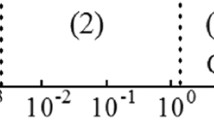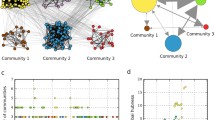Abstract
To better understand the diversity of dynamical patterns in the brain network of cerebral cortex, we study the collective behaviors of coupled neurons in complex networks with adaptive coupling. Based on the mutual interaction between dynamics and coupling strength in neuron systems, we let the coupling matrix evolve with the dynamics of neurons. We find that with suitable phase parameters, the coupling matrix will be self-organized into stabilized states and chimera states will be induced. The patterns of these chimera states may be different and abundant, depending on the different network topologies such as the fully connected, random, and scale-free networks. In particular, we apply this adaptive model to the realistic network of cerebral cortex and interestingly find that the adaptive coupling can also induce a diversity of chimera states, which may provide a new insight for the high capability of flexible brain functions. Moreover, we find that the preference of observing chimera states in heterogeneous networks is greater than that in homogeneous networks, and the latter is greater than that in the fully connected network, which may be one of the reasons for the nature to choose the specific sparse and heterogeneous structure of our brain network.














Similar content being viewed by others
References
Acebron, J.A., Bonilla, L.L., Vicente, C.J.P., Ritort, F., Spigler, R.: The kuramoto model: a simple paradigm for synchronization phenomena. Rev. Mod. Phys. 77, 137 (2005)
Boccaletti, S., Latora, V., Moreno, Y.: Complex networks: structure and dynamics. Phys. Rep. 424, 175 (2006)
Arenas, A., Diaz-Guilera, A., Kurths, J., Moreno, Y., Zhou, C.: Synchronization in complex networks. Phys. Rep. 469, 93 (2008)
Gomez-Gardenes, J., Gomez, S., Arenas, A., Moreno, Y.: Explosive synchronization transitions in scale-free networks. Phys. Rev. Lett. 106, 128701 (2011)
Zhang, X., Hu, X., Kurths, J., Liu, Z.: Explosive synchronization in a general complex network. Phys. Rev. E 88, 010802(R) (2013)
Zhang, X., Zou, Y., Boccaletti, S., Liu, Z.: Explosive synchronization as a process of explosive percolation in dynamical phase space. Sci. Rep. 4, 5200 (2014)
Kim, M., Mashour, G.A., Moraes, S., Vanini, G., Tarnal, V., Janke, E., Hudetz, A.G., Lee, U.: Functional and topological conditions for explosive synchronization develop in human brain networks with the onset of anesthetic-induced unconsciousness. Front. Comput. Neurosci. 10, 1 (2016)
Zhang, X., Boccaletti, S., Guan, S., Liu, Z.: Explosive synchronization in adaptive and multilayer networks. Phys. Rev. Lett. 114, 038701 (2015)
Peron, T.K.D.M., Rodrigues, F.A.: Determination of the critical coupling of explosive synchronization transitions in scale-free networks by mean-field approximations. Phys. Rev. E 86, 056108 (2012)
Zou, Y., Pereira, T., Small, M., Liu, Z., Kurths, J.: Basin of attraction determines hysteresis in explosive synchronization. Phys. Rev. Lett. 112, 114102 (2014)
Bi, H., Hu, X., Boccaletti, S., Wang, X., Zou, Y., Liu, Z., Guan, S.: Coexistence of quantized, time dependent, clusters in globally coupled oscillators. Phys. Rev. Lett. 117, 204101 (2016)
Ji, P., Peron, T.K.D.M., Menck, P.J., Rodrigues, F.A., Kurths, J.: Cluster explosive synchronization in complex networks. Phys. Rev. Lett. 110, 218701 (2013)
Kuramoto, Y., Battogtokh, D.: Coexistence of coherence and incoherence in nonlocally coupled phase oscillators. Nonlinear Phenom. Complex Syst. 5, 380 (2002)
Sethia, G.C., Sen, A., Atay, F.M.: Clustered chimera states in delay-coupled oscillator systems. Phys. Rev. Lett. 100, 144102 (2008)
Abrams, D.M., Strogatz, S.H.: Chimera states for coupled oscillators. Phys. Rev. Lett. 93, 174102 (2004)
Omelchenko, E., Maistrenko, Y.L., Tass, P.A.: Chimera states: the natural link between coherence and incoherence. Phys. Rev. Lett. 100, 044105 (2008)
Martens, E.A., Laing, C.R., Strogatz, S.H.: Solvable model of spiral wave chimeras. Phys. Rev. Lett. 104, 044101 (2010)
Omelchenko, I., Provata, A., Hizanidis, J., Schöll, E., Hövel, P.: Robustness of chimera states for coupled Fitzhugh–Nagumo oscillators. Phys. Rev. E 91, 022917 (2015)
Boccaletti, S., Almendral, J.A., Guan, S., Leyva, I., Liu, Z., Sendiña-Nadal, I., Zou, Y.: Explosive transitions in complex networks structure and dynamics: percolation and synchronization. Phys. Rep. 660, 1 (2016)
Abrams, D.M., Mirollo, R., Strogatz, S.H., Wiley, D.A.: Solvable model for chimera states of coupled oscillators. Phys. Rev. Lett. 101, 084103 (2008)
Sakaguchi, H.: Instability of synchronized motion in nonlocally coupled neural oscillators. Phys. Rev. E 73, 031907 (2006)
Pikovsky, A., Rosenblum, M.: Partially integrable dynamics of hierarchical populations of coupled oscillators. Phys. Rev. Lett. 101, 264103 (2008)
Rattenborg, N.C., Amlaner, C.J., Lima, S.L.: Behavioral, neurophysiological and evolutionary perspectives on unihemispheric sleep. Neurosci. Biobehav. Rev. 24, 817 (2000)
Mathews, C.G., Lesku, J.A., Lima, S.L., Amlaner, C.J.: Asynchronous eye closure as an anti-predator behavior in the western fence lizard. Ethology 112, 286 (2006)
Ma, R., Wang, J., Liu, Z.: Robust features of chimera states and the implementation of alternating chimera states. Europhys. Lett. 91, 40006 (2010)
Tamaki, M., Bang, J.W., Watanabe, T., Sasaki, Y.: Night watch in one brain hemisphere during sleep associated with the first-night effect in humans. Curr. Biol. 26, 1190 (2016)
Omelchenko, I., Omel’chenko, E., Hövel, P., Schöll, E.: When nonlocal coupling between oscillators becomes stronger: patched synchrony or multichimera states. Phys. Rev. Lett. 110, 224101 (2013)
Hizanidis, J., Kanas, V.G., Bezerianos, A., Bountis, T.: Chimera states in networks of nonlocally coupled hindmarsh-rose neuron models. T. Int. J. Bifurc. Chaos 24, 1450030 (2014)
Olmi, S., Politi, A., Torcini, A.: Collective chaos in pulse-coupled neural networks. Europhys. Lett. 92, 60007 (2010)
Santos, M.S., Szezech, J.D., Borges, F.S., Iarosz, K.C., Caldas, I.L., Batista, A.M., Viana, R.L., Kurths, J.: Chimera-like states in a neuronal network model of the cat brain. Chaos Solitons Fractals 101, 86 (2017)
Hizanidis, J., Kouvaris, N.E., Zamora-Lopez, G., Diaz-Guilera, A., Antonopoulos, C.G.: Chimera-like states in modular neural networks. Sci. Rep. 6, 19845 (2016)
Tian, C., Bi, H., Zhang, X., Guan, S., Liu, Z.: Asymmetric couplings enhance the transition from chimera state to synchronization. Phys. Rev. E 96, 052209 (2017)
Tian, C., Zhang, X., Wang, Z., Liu, Z.: Diversity of chimera-like patterns from a model of 2D arrays of neurons with nonlocal coupling. Front. Phys. 12, 128904 (2017)
Bi, G.Q., Poo, M.M.: Synaptic modifications in cultured hippocampal neurons: dependence on spike timing, synaptic strength, and postsynaptic cell type. J. Neurosci. 18, 10464 (1998)
Markram, H., Lubke, J., Frotscher, M., Sakmann, B.: Regulation of synaptic efficacy by coincidence of postsynaptic aps and epsps. Science 275, 213 (1997)
Caporale, N., Dan, Y.: Spike timing-dependent plasticity: a hebbian learning rule. Ann. Rev. Neurosci. 31, 25 (2008)
Hebb, D.O.: The Organization of Behavior. Wiley, New York (1949)
Tero, A., et al.: Rules for biologically inspired adaptive network design. Science 327, 439 (2010)
Harris, K.D., et al.: Organization of cell assemblies in the hippocampus. Nature (London) 424, 552 (2003)
Gross, T., Blasius, B.: Cascade dynamics of complex propagation. J. R. Soc. Interface 5, 259 (2008)
Aoki, T., Aoyagi, T.: Self-organized network of phase oscillators coupled by activity-dependent interactions. Phys. Rev. E 84, 066109 (2011)
Gutierrez, R., Amann, A., Assenza, S., Gomez-Gardenes, J., Latora, V., Boccaletti, S.: Emerging meso-and macroscales from synchronization of adaptive networks. Phys. Rev. Lett. 107, 234103 (2011)
Aoki, T.: Self-organization of a recurrent network under ongoing synaptic plasticity. Neural Netw. 62, 11 (2015)
Kasatkin, D.V., Yanchuk, S., Scholl, E., Nekorkin, V.I.: Self-organized emergence of multilayer structure and chimera states in dynamical networks with adaptive couplings. Phys. Rev. E 96, 062211 (2017)
Wang, H., Li, X.: Synchronization and chimera states of frequency-weighted Kuramoto-oscillator networks. Phys. Rev. E 83, 066214 (2011)
Chandrasekar, V.K., Sheeba, J.H., Subash, B., Lakshmanan, M., Kurths, J.: Adaptive coupling induced multi-stable states in complex networks. Physica D 267, 36 (2014)
Kemeth, F.P., Haugland, S.W., Schmidt, L., Kevrekidis, I.G., Krischer, K.: A classification scheme for chimera states. Chaos 26, 094815 (2016)
Zhu, Y., Zheng, Z., Yang, J.: Chimera states on complex networks. Phys. Rev. E 89, 022914 (2014)
Albert, R., Barabasi, A.: Statistical mechanics of complex networks. Rev. Mod. Phys. 74, 47 (2002)
Liu, Z., Lai, Y.C., Ye, N., Dasgupta, P.: Connectivity distribution and attack tolerance of general networks with both preferential and random attachments. Phys. Lett. A 303, 337 (2002)
Hagmann, P., Cammoun, L., Gigandet, X., Meuli, R., Honey, C.J., Wedeen, J.V., Sporns, O.: Mapping the structural core of human cerebral cortex. PLoS Biol. 6, 1479 (2008)
Honey, C.J., Sporns, O., Cammoun, L., Gigandet, X., Thiran, J.P., Meuli, R., Hagmann, P.: Predicting human resting-state functional connectivity from structural connectivity. Proc. Natl. Acad. Sci. USA 106, 2035 (2009)
Hong, H., Strogatz, S.H.: Kuramoto model of coupled oscillators with positive and negative coupling parameters: an example of conformist and contrarian oscillators. Phys. Rev. Lett. 106, 054102 (2011)
Borgers, C., Kopell, N.: Synchronization in networks of excitatory and inhibitory neurons with sparse, random connectivity. Neural Comput. 15, 509 (2003)
Restrepo, J.G., Ott, E., Hunt, B.R.: Synchronization in large directed networks of coupled phase oscillators. Chaos 16, 015107 (2006)
Zhang, X., Guan, S., Zou, Y., Chen, X., Liu, Z.: Suppressing explosive synchronization by contrarians. Europhys. Lett. 113, 28005 (2016)
Soriano, J., Martinez, M.R., Tlusty, T., Moses, E.: Development of input connections in neural cultures. Proc. Natl. Acad. Sci. USA 105, 13758 (2008)
Vogels, T.P., Abbott, L.F.: Gating multiple signals through detailed balance of excitation and inhibition in spiking networks. Nat. Neurosci. 12, 483 (2009)
Seliger, P., Young, S.C., Tsimring, L.S.: Plasticity and learning in a network of coupled phase oscillators. Phys. Rev. E 65, 041906 (2002)
Tang, J., Zhang, J., Ma, J., Luo, J.: Noise and delay sustained chimera state in small world neuronal network. Sci. China Technol. Sci. 61, (2018). https://doi.org/10.1007/sl1431-017-9282-x
Liu, Z., Lai, Y.C.: Coherence resonance in coupled chaotic oscillators. Phys. Rev. Lett. 86, 4737 (2001)
Zhan, M., Wei, G., Lai, C., Lai, Y.C., Liu, Z.: Coherence resonance near the hopf bifurcation in coupled chaotic oscillators. Phys. Rev. E 66, 036201 (2002)
Zhu, L., Lai, Y.C., Liu, Z., Raghu, A.: Can noise make nonbursting chaotic systems more regular? Phys. Rev. E 66, 015204 (2002)
Liu, Z., Lai, Y.C., Lopez, J.M.: Noise-induced enhancement of chemical reactions in chaotic flows. Chaos 12, 417 (2002)
Acknowledgements
This work was partially supported by the NNSF of China under Grant Nos. 11675056 and 11835003.
Author information
Authors and Affiliations
Corresponding author
Ethics declarations
Competing interest
The authors declare that they have no competing interests.
Additional information
Publisher's Note
Springer Nature remains neutral with regard to jurisdictional claims in published maps and institutional affiliations.
Rights and permissions
About this article
Cite this article
Huo, S., Tian, C., Kang, L. et al. Chimera states of neuron networks with adaptive coupling. Nonlinear Dyn 96, 75–86 (2019). https://doi.org/10.1007/s11071-019-04774-4
Received:
Accepted:
Published:
Issue Date:
DOI: https://doi.org/10.1007/s11071-019-04774-4




